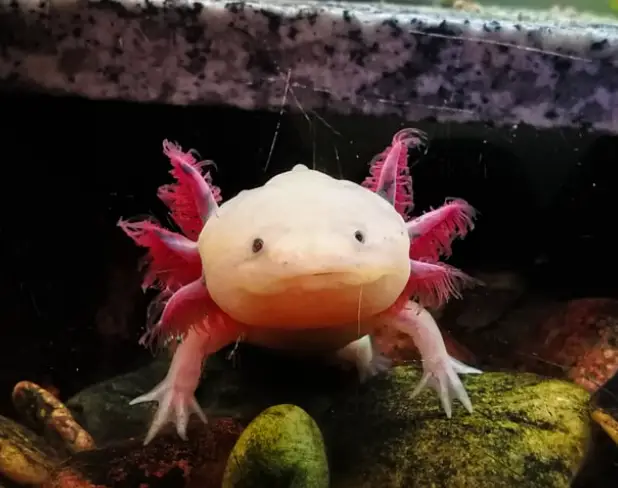Axolotls are an interesting amphibian pet option that can be found all throughout the nation. GFP, or green fluorescent protein, is a protein that is injected into albino axolotls to cause their bodies to shine.
The GFP axolotl is among the most fascinating axolotl species, not just because of how adorable they are to look at or hear, but also because they make excellent pets.
They attract a lot of interest due to their extraordinary ability to glow in UV light, but if you want to keep one in your home aquarium, you must be keen to understand more about them than just their outward appearance.
Why Are GFP Axolotls so Unique?
With the use of animal research, several axolotls were able to alter their genetic makeup, which helps to explain how the GFP (Green fluorescent protein) mutation evolved.
Inside one form of jellyfish, the GFP gene produces a shiny-colored enzyme from numerous axolotl molecules. When exposed to UV light, it also gives the skin of GFP variations a dazzling fluorescent green appearance.
Scientists working on human leg recovery and organ transplantation may find this ability to be of great use. Additionally, the skill is effectively transmitted from one generation to the next. This effect is not only due to carotenoid molecules and is not likely to be impacted by the mosaicism of the axolotl.
The most well-known fact about axolotls is that they frequently reside at Xochimilco Lake in Mexico City. Despite the fact that many of these species are rare and endangered in the wild, they are conserved in labs and tanks.
There are a number of reasons why scientists have decided to study this particular species. Axolotls make excellent research subjects because of their extraordinary capacity to repair amputated limbs.
The distinct color variations of axolotls, however, aren’t due to genetic reproduction; in fact, the majority of them were created in labs using scientific methods. Examples of human-made color changes include GFP axolotls.
Albinos that have had a particular type of protein pumped into them to give them an extraordinary overall glow are frequently GFP axolotls.
What Are The Characteristics Of A GFP?
The GFP axolotl was created through animal experimentation; it is not a genuine species. When exposed to UV light, it takes on a bright neon green appearance. And to make albino axolotls glow, scientists give them a special protein to inject.
That is, the green fluorescent protein causes them to grow while it is present in their bodies. So, essentially, any kind of axolotl can be a GFP axolotl as long as it contains the protein.
Since it was found that axolotls are capable of regeneration, humans have been fascinated by and conducting experiments with them. Thus, the reason why GFP, firefly, mosaic, and other rare types of species exist.
- Color and appearance
When researchers were looking at cancer cell regeneration, they found the GFP. The newly discovered gene was thought to be fantastic, therefore they were passed on from father to son.
GFP axolotls allow you to view the green protein, especially when they shine in the dark. This characteristic is more prevalent in albino axolotls because it helps the GFP in them shine more brightly when exposed to light.
This is not to say that other axolotls cannot glow; however, the brightness depends on the axolotl’s pigmentation. An axolotl becomes a GFP axolotl once it has the green fluorescent protein.
- Size
It is fair to say that GFP axolotls tend to grow between 10 and 18 inches longer than other varieties. They can grow up to 18 inches or less depending on how well you feed and care for them, despite the fact that the difference isn’t really noticeable when compared to others.
- Temperament
Axolotls are often docile creatures, making people feel comfortable keeping them as pets. Despite the fact that GFP axolotls have undergone experimentation, this is the same for them.
Even though they don’t appear to be domestic, they are, and until you have a large number of juveniles in your tank, you won’t have much trouble keeping them.
- Lifespan
A GFP axolotl lives about as long as other axolotls do. You can anticipate them to survive for at least fifteen years if you take good care of them and feed them the proper foods.
However, they typically have a minimum life expectancy of 10 years and a maximum life expectancy of 15 years. However, some can survive up to 20 years before they pass away; this largely relies on you.
How Care For GFP Axolotls
You should pay close attention to the axolotl’s tank, water, and food when it comes to axolotl maintenance. The major issues axolotls have typically originate in these three areas.
- Tank Management
An axolotl places importance on tank capacity. They enjoy having room to move around and a variety of terrain in which to hide from things like sunshine.
Axolotls can reach lengths of up to 18 inches. Accordingly, you should definitely aim for a 20-gallon tank per axolotl. This kind of tank might be useful for you.
This is crucial if you have multiple axolotls because they have cannibalistic inclinations that are more pronounced in cramped quarters.
- Tank Lid
Purchase a tank cover regardless of the tank size you choose. When axolotls are startled, their instinctive response is to jump out of the water. The axolotl will leap out of the tank if there is no lid.
Since axolotls cannot survive without water, they risk serious injury if they jump out of the tank while you’re away. Prevent this. Purchase a tank cover.
- Substrate
What type of tank covering you employ is another important tank feature that you should think about. The substrate used to cover the bottom of your tank is called tank covering. This is crucial for axolotls since they rely on the substrate to assist them to move along the ground as they crawl. They find plain glass to be too slippery.
Without the right substrate, an axolotl will experience more stress, which can develop into a variety of medical issues brought on by their inability to move in the way they would like.
Stick with a very fine-grained substrate (like sand) or very huge rocks/gravel when picking a substrate for your tank. Anything an axolotl could ingest that is small enough to impede its digestive system should be avoided. If possible, an axolotl will consume its substrate. Because of this, little stones are one of the main sources of health problems in axolotls.
- Water Parameters
The ideal water environment is crucial for GFP Axolotls. They can frequently manage a few variations, though. They can resist pH values between 6.8 and 8. The ideal pH range is 7.4 to 7.6, though. The water in the aquarium needs to be between 60 and 64 degrees Fahrenheit.
Additionally, the ammonium level in your pet’s storage tank must not rise above 0 ppm; anything higher could endanger the life of your fish. Nitrate concentrations between 2 and 40 ppm are necessary for these species. If the sum is higher, your axolotls’ lives may be gravely in risk.
- Filtration Mechanism
Aquarium filtration should be effective for axolotls. If the water is not pure, they may struggle and catch various infections. The filtration system in your fish tank must be of the highest caliber as a result.
However, the filters you install shouldn’t cause a rapid flow in their calm water and hinder your axolotl’s ability to swim.
As a result, it is suggested that a spongy filtration system is useful in these situations since it effectively cleanses the water without producing waves.
- Diet & Food
It shouldn’t be difficult for you to feed your axolotl. The meat-eating salamanders can eat a variety of meals.
In order for them to grow and live their lives to the fullest, you also need to give them the best, healthiest meals you can.
It is advisable that you avoid feeding the axolotls any bloodworms or small fish that you have captured. You can never be sure when the fish you catch might be infected. It is therefore advised to avoid doing this.
Conclusion
It’s interesting to keep unusual animals like GFP axolotls. If you take good care of them, they will enhance your aquarium for a long time in addition to their color and UV shine.
You must correctly set the specifications for their nutrition, tank and water, and general maintenance. If you want them to live a long time, their food must also be optimal.
Additionally, GFP axolotls can reproduce quickly, so you should avoid purchasing both genders if you don’t plan to rear young axolotls. In addition, we strongly advise against doing such, especially if you are unfamiliar with them.







